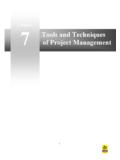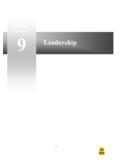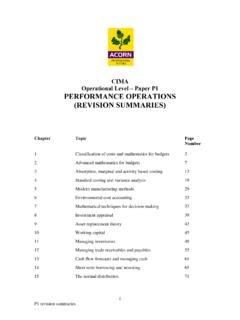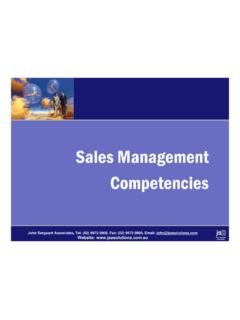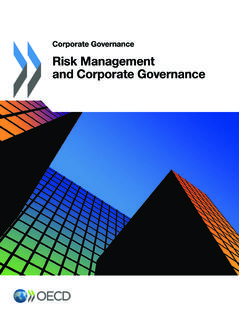Transcription of Chapter Operations Management 6 - acornlive.com
1 1 Operations Management Chapter 6 2 Overview of Operations Management Operations strategy The total pattern of decisions which shape the long-term capabilities of any type of Operations and their contribution to the overall strategy, through the reconciliation of market requirements with Operations resources. ( Definition: Slack and Lewis) Organisations make products or deliver services and do rely heavily upon operational processes to produce effective products and efficiently deliver them on time.
2 Operational functions or departments have the responsibility for the transformational process of converting business inputs staff, materials, machines, money etc, to produce a final product, in a way that adds value to customers creates profit margin. These functions can be critical to gaining competitive advantage for an organisation . Major operational functions within the organisation Marketing and sales identifying needs, wants and values of customers. Production administration of orders, physical manufacture and assembly, effective delivery etc. Research and development vital innovation for new products or processes.
3 Customer support customer service, after sales service, customer support etc. Value is the reason why customers choose one rivals product over another, if an organisation can offer certain unique features from their operational Management , a customer could be willing to pay extra for it and could remain more loyal to the organisation . Aesthetics, reliability, durability, product functions and features, novelty, designs, colours and even the courtesy and friendliness of staff involved in the selling and customer support services, can make a massive difference to customer value. But this relies upon an effective operational strategy.
4 Performance dimensions for operational strategy Quality Marks & Spencer, Thornton s, BMW etc all are synonymous with the image of high quality. Quality means fitness for the purpose, so this dimension would include other characteristics such as how the product functions and how robust and reliable it is. Speed The AA or RAC could offer superior call out response times, Concorde when it was first launched gave the fastest transatlantic flights, courier companies like FedEx Express can guarantee overnight global parcel delivery. Flexibility ability to increase or decrease production to meet customer demands, coffee shops, hair dressers and call centres and how they all respond to peak times is one such focus of this dimension.
5 Multi-skilled staff can help an organisation achieve greater flexibility and economies of scope. Cost aiming to offer a product or service at the lowest possible price, a cost leadership strategy. Cheap and cheerful products like supermarket own economy brands or basic no frills services like Easy Jet and Ryan Air. 3 Porter s value chain analysis Value chain analysis (VCA) is a position audit tool which examines the current and internal position of an organisation . It is ideal tool to examine holistically the operational processes of an organisation . According to professor Michael Porter, an organisation receives inputs or resources from its environment and converts these to outputs products or services.
6 In doing so it achieves added value by this process, creating margin or profit for the organisation . Value is the reason why customers choose one rivals product over another, either because the product or service is lower in price or it offers certain features the customer is willing to pay extra for. Porter grouped the various business processes or activities of an organisation into what he called the value chain; he divided the organisations activities into nine types, classified as either primary or secondary activities. These activities incur costs, but in combination with other activities provide customer satisfaction and therefore added value.
7 Primary activities are processes or activities directly involved in the provision of the good or service the organisation makes or provides inbound logistics, Operations , outbound logistics, marketing/sales and after sales service Secondary or support activities support the primary activities by providing necessary support and resources, but are not directly involved in the provision of the good or service the organisation makes or provides infrastructure, human resource Management (HRM), technology and procurement Activities are business processes the organisation manages in order to add value the product or service is worth more than the cost of the individual parts or resources used to provide it, this allows a margin to be earned by the organisation A value chain is the sequence of business activities by which, in the perspective of the end user, value is added to the products or services produced by an organisation (CIMA).
8 Infrastructure HRM Technology Procurement Inbound Logistics Operations Outbound Logistics Marketing & Sales After Sales Service Primary activities Margin Margin Secondary activities 4 Inbound logistics Business processes which receive, handle and store inputs warehousing, stock control and inbound transport. Operations Business processes which convert inputs to output staff, materials, and machines used to assemble the final product, or provide a service.
9 Outbound logistics Business processes which deliver the actual product (output), when it leaves the organisation outbound storage and transport of goods to the customer. Marketing & Sales Business processes of selling, researching customer needs and development of an effective marketing mix product features, price, promotion and place, to satisfy customers. After sales service Business processes that deal with returns, complaints and customer support after the product or service (output) has left the organisation customer service and support teams, repair and warranty departments to supply parts or consumables, and after sales servicing.
10 Procurement Business processes to manage and negotiate the acquisition of resources (inputs) for the primary activities components, raw materials and equipment. Ensures resources that are required are in the right place at the right time and right cost purchasing departments. Technology development Business processes required for innovation, product design and testing, or the invention of new processes research and development (R&D) departments. Human resource Management (HRM) Business processes to procure and look after the organisations most valued asset its staff staff recruitment, selection, training, development, retention, induction, reward systems, appraisals and the maintenance of staff records.
